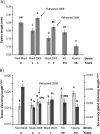Differential effects of inbreeding and selection on male reproductive phenotype associated with the colonization and laboratory maintenance of Anopheles gambiae
- PMID: 24418094
- PMCID: PMC3896703
- DOI: 10.1186/1475-2875-13-19
Differential effects of inbreeding and selection on male reproductive phenotype associated with the colonization and laboratory maintenance of Anopheles gambiae
Abstract
Background: Effective mating between laboratory-reared males and wild females is paramount to the success of vector control strategies aiming to decrease disease transmission via the release of sterile or genetically modified male mosquitoes. However mosquito colonization and laboratory maintenance have the potential to negatively affect male genotypic and phenotypic quality through inbreeding and selection, which in turn can decrease male mating competitiveness in the field. To date, very little is known about the impact of those evolutionary forces on the reproductive biology of mosquito colonies and how they ultimately affect male reproductive fitness.
Methods: Here several male reproductive physiological traits likely to be affected by inbreeding and selection following colonization and laboratory rearing were examined. Sperm length, and accessory gland and testes size were compared in male progeny from field-collected females and laboratory strains of Anopheles gambiae sensu stricto colonized from one to over 25 years ago. These traits were also compared in the parental and sequentially derived, genetically modified strains produced using a two-phase genetic transformation system. Finally, genetic crosses were performed between strains in order to distinguish the effects of inbreeding and selection on reproductive traits.
Results: Sperm length was found to steadily decrease with the age of mosquito colonies but was recovered in refreshed strains and crosses between inbred strains therefore incriminating inbreeding costs. In contrast, testes size progressively increased with colony age, whilst accessory gland size quickly decreased in males from colonies of all ages. The lack of heterosis in response to crossing and strain refreshing in the latter two reproductive traits suggests selection for insectary conditions.
Conclusions: These results show that inbreeding and selection differentially affect reproductive traits in laboratory strains overtime and that heterotic 'supermales' could be used to rescue some male reproductive characteristics. Further experiments are needed to establish the exact relationship between sperm length, accessory gland and testes size, and male reproductive success in the laboratory and field settings.
Figures





References
-
- Ranson H, N’Guessan R, Lines J, Moiroux N, Nkuni Z, Corbel V. Pyrethroid resistance in African anopheline mosquitoes: what are the implications for malaria control? Trends Parasitol. 2011;27:91–98. - PubMed
-
- Mitchell SN, Stevenson BJ, Muller P, Wilding CS, Egyir-Yawson A, Field SG, Hemingway J, Paine MJI, Ranson H, Donnelly MJ. Identification and validation of a gene causing cross-resistance between insecticide classes in Anopheles gambiae from Ghana. Proc Natl Acad Sci USA. 2012;109:6147–6152. - PMC - PubMed
-
- Benedict MQ, Robinson AS. The first releases of transgenic mosquitoes: an argument for the sterile insect technique. Trends Parasitol. 2003;19:349–355. - PubMed
Publication types
MeSH terms
Grants and funding
LinkOut - more resources
Full Text Sources
Other Literature Sources

